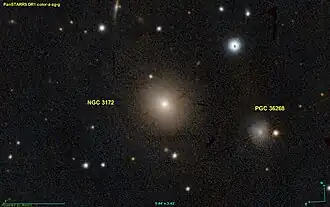NGC 3172
| NGC 3172 | |
|---|---|
 NGC 3172 imaged by Pan-STARRS | |
| Observation data (J2000 epoch) | |
| Constellation | Ursa Minor |
| Right ascension | 11h 47m 11.928s[1] |
| Declination | +89° 05′ 35.77″[1] |
| Redshift | 0.020334±0.0000970[2] |
| Heliocentric radial velocity | 6,096±29 km/s[2] |
| Distance | 291.4 ± 20.5 Mly (89.33 ± 6.28 Mpc)[2] |
| Apparent magnitude (V) | 14.9[1] |
| Characteristics | |
| Type | S0[3] |
| Apparent size (V) | 0.92′ × 0.79′[1] |
| Notable features | Closest NGC object to the north celestial pole |
| Other designations | |
| MCG +15-01-011, PGC 36847, CGCG 370-002[2] | |
NGC 3172 (also known as Polarissima Borealis[1]) is a lenticular galaxy located in the constellation Ursa Minor. It is the closest NGC object to the north celestial pole.[1] Discovered by John Herschel in 1831, it is about 285 million light-years away and about 85 thousand light-years across.[4]
Supernovae
Two supernovae have been observed in NGC 3172:
- SN 2010af (Type Ia, mag. 17.2), was discovered by Tom Boles on 4 March 2010.[5][6]
- SN 2017gla (Type Ia, mag. 16), was discovered on by Giancarlo Cortini on 1 September 2017.[7]
See also
- NGC 2573 - the closest NGC object to the south celestial pole.
- List of NGC objects (3001–4000)
References
- ^ a b c d e f SIMBAD:%20NGC%203054%20--%20Galaxy "NGC 3172". sim-id. Retrieved 2020-05-29.
- ^ a b c d "Results for object NGC 5442". NASA/IPAC Extragalactic Database. NASA and Caltech. Retrieved 18 August 2025.
- ^ "Search specification: NGC 3172". HyperLeda. Université Claude Bernard Lyon 1. Retrieved 2021-02-24.
- ^ "New General Catalog Objects: NGC 3150 - 3199". cseligman.com. Retrieved 2020-05-30.
- ^ Boles, T. (2010). "Supernova 2010af in NGC 3172". Central Bureau Electronic Telegrams (2194): 1. Bibcode:2010CBET.2194....1B.
- ^ "SN 2010af". Transient Name Server. IAU. Retrieved 18 August 2025.
- ^ "SN 2017gla". Transient Name Server. IAU. Retrieved 18 August 2025.
External links
- SIMBAD: NGC 3054 -- Galaxy
- NGC 3172 on WikiSky: DSS2, SDSS, GALEX, IRAS, Hydrogen α, X-Ray, Astrophoto, Sky Map, Articles and images